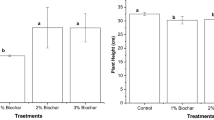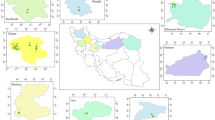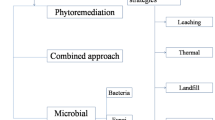Abstract
Copper production in the Bor region (east Serbia) during the last 100 years has influenced the quality of soil, water, and air. This pollution has endangered not only the biotope but all living organisms, including humans. Contents of arsenic (As) and cadmium (Cd) were analyzed in Betula sp. (birch) and Tillia sp. (lime) within the Bor region with the aim to investigate the bioaccumulation of these highly toxic, nonessential trace elements in selected plants, which may be important for biomonitoring and bioremediation purposes. The results of statistical data analysis showed that several factors influenced the bioaccumulation of trace elements in the examined plants, of which soil pH, soil content, and mechanism of accumulation were the main factors. The greatest As and Cd concentrations were found in plant material from the Bor center sampling site in the urban/industrial zone, which is in close proximity to the pollution source, due to the greatest metal concentrations in soil and the lowest soil pH. The low values of biological accumulation coefficients (bioconcentration factor <1, mobility ratio <1) pointed to a low rate of uptake and accumulation of As and Cd in lime and birch. Trace elements showed different patterns of behavior and accumulation in the trees. Lime showed a high ability of assimilation through leaves, whereas birch showed a better potential to express a linear correlation between concentrations in plant parts and soil.

Similar content being viewed by others
References
Angle JS, Linacre NA (2005) Metal phytoextraction—a survey of potential risks. Int J Phytoremediat 7:241–254
Antonijevic M, Maric M (2008) Determination of the content of heavy metals in pyrite contaminated soil and plants. Sensors (Basel) 8(9):5857–5865
Bech J, Duran P, Roca N, Poma W, Sánchez, I, Roca-Pérez L et al (2012) Accumulation of Pb and Zn in Bidens triplinervia and Senecio sp. spontaneous species from mine spoils in Peru and their potential use in phytoremediation. J Geochem Explor
Brekken A, Steinnes E (2004) Seasonal concentrations of cadmium and zinc in native pasture plants: consequences for grazing animals. Sci Total Environ 326:181–195
Callan AC, Winters M, Barton C, Boyce M, Hinwood AL (2012) Children’s exposure to metals: a community-initiated study. Arch Environ Contam Toxicol 62:714–722
Cosio C, Martinoia E, Keller C (2004) Hyperaccumulation of cadmium and zinc in Thlaspi caerulescens and Arabidopsis halleri at the leaf cellular level. Plant Physiol 134:716–725
Cunningham SD, Ow DW (1996) Promises and prospects of phytoremediation. Plant Physiol 110:715–719
Dmuchowski W, Bytnerowicz A (2009) Long-term (1992–2004) record of lead, cadmium, and zinc air contamination in Warsaw, Poland: determination by chemical analysis of moss bags and leaves of Crimean lime. Environ Pollut 157:3413–3421
Duker AA, Carranza EJM, Hale M (2005) Arsenic geochemistry and health. Environ Int 31:631–641
Fernandez R, Bertrand A, Casares A, Garcia R, Gonzalez A, Tames RS (2008) Cadmium accumulation and its effect on the in vitro growth of woody fleabane and mycorrhized white birch. Environ Pollut 152:522–529
Gisbert C, Almela C, Velez D, Lopez-Moya JR, de Haro A, Serrano R et al (2008) Identification of As accumulation plant species growing on highly contaminated soils. Int J Phytoremediat 10:185–196
International Organisation for Standardisation (2005) Soil quality: determination of pH. ISO 10390. ISO, Geneva
Kabata-Pendias A, Pendias H (2001) Trace elements in soils and plants. CRC Press, Boca Raton
Kadukova J, Manousaki E, Kalogerakis N (2008) Pb and Cd accumulation and phyto-excretion by salt cedar (Tamarix smyrnensis Bunge). Int J Phytoremediat 10:31–46
Kirkham MB (2006) Cadmium in plants on polluted soils: effects of soil factors, hyperaccumulation, and amendments. Geoderma 137:19–32
Kosiba P (2008) Variability of morphometric leaf traits in small-leaved linden (Tilia cordata mill.) under the influence of air pollution. Acta Soc Bot Pol 77(2):125–137
Küper H, Lombi E, Zhao F-J, McGrath SP (2000) Cellular compartmentation of cadmium and zinc in relation to other elements in the hyperaccumulator. Planta 212:75–84
Kuzovkina YA, Knee M, Quigley MF (2004) Cadmium and copper uptake and translocation in five willow (Salix L.) species. Int J Phytoremediat 6(3):269–287
Lai H-Y, Chen S-W, Chen Z-S (2008) Pot experiment to study the uptake of Cd and Pb by three Indian mustards (Brassica juncea) grown in artificially contaminated soils. Int J Phytoremediat 10:91–105
Liu H, Kottke I (2004) Subcellular localization of cadmium in the root cell of Allium cepa by electron energy loss spectroscopy and cytochemistry. J Biosci 29(3):329–335
Malik RN, Husain SZ, Nazir I (2010) Heavy metal contamination and accumulation in soil and wild plant species from industrial area of Islamabad, Pakistan. Pak J Bot 42(1):291–301
Maric M, Antonijevic M, Alagic S (2013) The investigation of the possibility for using some wild and cultivated plants as hyperaccumulators of heavy metals from contaminated soil. Environ Sci Pollut Res 20(2):1181–1188
Marjanović T, Trumić M, Marković Lj, (2003) Local Environmental Action Plan of Bor, Bor
Marques APGC, Rangel AOSS, Castro PML (2009) Remediation of heavy metal contaminated soils: phytoremediation as a potentially promising clean-up technology. Crit Rev Environ Sci Technol 39:622–654
Mazej Z, Al Sayegh-Petkovsek S, Pokorny B (2010) Heavy metal concentrations in food chain of Lake Velenjsko Jezero, Slovenia: an artificial lake from mining. Arch Environ Contam Toxicol 58:998–1007
McGrath SP, Zhao FJ (2003) Phytoextraction of metals and metalloids from contaminated soils. Curr Opin Biotech 14:277–282
Miller JN, Miller JC (2005) Statistics and chemometrics for analytical chemistry. Pearson Education Limited, London
Mingorance MD, Rossini Oliva S (2006) Heavy metals content in N. Oleander leaves as urban pollution assessment. Environ Monit Assess 119:57–68
Mingorance MD, Valdés B, Oliva RS (2007) Strategies of heavy metal uptake by plants growing under industrial emissions. Environ Int 33:514–520
Moriarty MM, Koch I, Reimer KJ (2012) Arsenic speciation, distribution, and bioaccessibility in shrews and their food. Arch Environ Contam Toxicol 62:529–538
Mourón SA, Golijow CD, Dulout FN (2001) DNA damage by cadmium and arsenic salts assessed by the single cell gel electrophoresis assay. Mutat Res 498:47–55
Oskarsson A, Widell A, Olsson I-M, Grawé KP (2004) Cadmium in food chain and health effects in sensitive population groups. Biometals 17(5):531–534
Ouyang Y (2005) Phytoextraction: simulating uptake and translocation of arsenic in a soil–plant system. Int J Phytoremediat 7(1):3–17
Piczak K, Leśniewicz AL, Żyrnicki W (2003) Metal concentrations in deciduous tree leaves from urban areas in Poland. Environ Monit Assess 86:273–287
Rascio N, Navari-Izzo F (2011) Heavy metal hyperaccumulating plants: how and why do they do it? And what makes them so interesting? Plant Sci 180:169–181
Raskin I, Smith RD, Salt DE (1997) Phytoremediation of metals using plants to remove pollutants from the environment. Curr Opin Biotech 8:221–226
Reimann C, Koller F, Kashulina G, Niskavaara H, Englmaier P (2001) Influence of extreme pollution on the inorganic chemical composition of some plants. Environ Pollut 115:239–252
Salido AL, Hasty KL, Lim J-M, Butcher DJ (2003) Phytoremediation of arsenic and lead in contaminated soil using Chinese brake ferns (Pteris vittata) and indian mustard (Brassica juncea). Int J Phytoremediat 5(2):89–103
Samecka-Cymerman A, Stankiewicz A, Kolon K, Kempers AJ (2009a) Bioindication of trace metals in Brachythecium rutabulum around a copper smelter in Legnica (Southwest Poland): use of a new form of data presentation in the form of a self-organizing feature map. Arch Environ Contam Toxicol 56:717–722
Samecka-Cymerman A, Kolon K, Kempers AJ (2009b) Short shoots of Betula pendula Roth. as bioindicators of urban environmental pollution in Wrocław (Poland). Trees-Struct Funct 23:923–929
Serbula SM, Antonijevic MM, Milosevic NM, Mili SM, Ilic AA (2010) Concentrations of particulate matter and arsenic in Bor (Serbia). J Hazard Mater 181:43–51
Serbula SM, Miljkovic DJD, Kovacevic MR, Ilic AA (2012a) Assessment of airborne heavy metal pollution using plant parts and topsoil. Ecotoxicol Environ Safe 76:209–214
Serbula SM, Alagić SČ, Ilić AA, Kalinović TS, Strojić JV (2012b) Particulate matter originated from mining-metallurgical processes. In: Knudsen H, Rasmunssen N (eds) Particulate matter: sources, emission rates and health effects. Nova Science, New York, pp 91–116
The Official Gazette of Republic of Serbia, No. 23/94
United States Environmental Protection Agency (1996) USEPA Method 3050B. Acid digestion of sediments, sludges, and soils. http://www.epa.gov/osw/hazard/testmethods/sw846/pdfs/3050b.pdf. Accessed 17 Aug 2013
Unterbrunner R, Puschenreiter M, Sommer P, Wieshammer G, Tlustos P, Zupan M et al (2007) Heavy metal accumulation in trees growing on contaminated sites in Central Europe. Environ Pollut 148:107–114
Vamerali T, Bandiera M, Mosca G (2010) Field crops for phytoremediation of metal-contaminated land. A review. Environ Chem Lett 8:1–17
Yang XX, Chen H, Dai XJ, Xu WZ, He ZY, Ma M (2009) Evidence of vacuolar compartmentalization of arsenic in the hyperaccumulator Pteris vittata. Chin Sci Bull 54(22):4229–4233
Zhang X, Zhang S, Xu X, Li T, Gong G, Jia Y (2010) Tolerance and accumulation characteristics of cadmium in Amaranthus hybridus L. J Hazard Mater 180:303–308
Acknowledgments
The authors are grateful to the Ministry of Education, Science and Technological Development of Serbia, for financial support (Project No. 46010).
Author information
Authors and Affiliations
Corresponding author
Rights and permissions
About this article
Cite this article
Alagić, S.Č., Šerbula, S.S., Tošić, S.B. et al. Bioaccumulation of Arsenic and Cadmium in Birch and Lime from the Bor Region. Arch Environ Contam Toxicol 65, 671–682 (2013). https://doi.org/10.1007/s00244-013-9948-7
Received:
Accepted:
Published:
Issue Date:
DOI: https://doi.org/10.1007/s00244-013-9948-7




